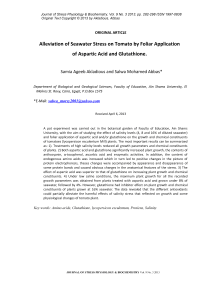Alleviation of seawater stress on tomato by foliar application of aspartic acid and glutathione
Автор: Akladious Samia Ageeb, Abbas Salwa Mohamed
Журнал: Журнал стресс-физиологии и биохимии @jspb
Статья в выпуске: 3 т.9, 2013 года.
Бесплатный доступ
A pot experiment was carried out in the botanical garden of Faculty of Education, Ain Shams University, with the aim of studying the effect of salinity levels (4, 8 and 16% of diluted seawater) and foliar application of aspartic acid and/or glutathione on the growth and chemical constituents of tomatoes (lycopersicon esculentum Mill) plants. The most important results can be summarized as: 1). Treatments of high salinity levels reduced all growth parameters and chemical constituents of plants. 2) Both aspartic acid and glutathione significantly increased plant growth, the contents of anthocyanin, α-tocopherol, ascorbic acid and enzymatic activities. In addition, the content of endogenous amino acids was increased which in turn led to positive changes in the picture of protein electrophoresis, theses changes were accompanied by appearance and disappearance of some protein bands and caused obvious changes in the anatomical features of the stems. 3) The effect of aspartic acid was superior to that of glutathione on increasing plant growth and chemical constituents. 4) Under low saline conditions, the maximum plant growth for all the recorded growth parameters was obtained from plants treated with aspartic acid and grown under 8% of seawater, followed by 4%. However, glutathione had inhibitor effect on plant growth and chemical constituents of plants grown at 16% seawater. The data revealed that the different antioxidants could partially alleviate the harmful effects of salinity stress that reflected on growth and some physiological changes of tomato plant.
Amino acids, glutathione, lycopersicon esculentum, protiens, salinity
Короткий адрес: https://sciup.org/14323774
IDR: 14323774
Текст научной статьи Alleviation of seawater stress on tomato by foliar application of aspartic acid and glutathione
Soil salinity is one of the most important abiotic stress and limiting factor for plant production. Up to 20% of the irrigated arable land in arid and semiarid regions is already salt affected and is still expanding (Koyro, 2006). Increasing NaCl concentration in nutrient solution adversely affected tomato shoot and roots, plant height, K concentration, and K/Na ratio.
Salt stress causes partial swelling of endoplasmic reticulum, decrease in mitochondrial cristase and swelling of mitochondria, fragmentation of tonoplast, and degradation of cytoplasm by the mixture of cytoplasmic and vacuolar matrices in leaves of sweet potato (Mitsuya et al., 2000). The important response of salt stress is reduction in the rate of leaf surface expansion leading to cessation of expansion as salt concentration increases. Salt stress causes water deficit because of osmotic effects on metabolic activities of plants and this water deficit results in oxidative stress because of the formation of reactive oxygen species. The most common stress responses in plants is overproduction of compatible organic solutes which are low molecular weight, highly soluble compounds that are usually nontoxic at high cellular concentrations (Azevedo et al., 2004). The plants defend against these reactive oxygen species by induction of activities of certain antioxidative enzymes such as catalase, peroxidase, glutathione reductase, and superoxide dismutase, which scavenge reactive oxygen species. Activities of antioxidative enzymes increase under salt stress in wheat (Hernandez et al., 2000).
The increasing of soil salinity by irrigation with saline water resulted in increased the sodium content and also the relationships of Na+/Ca2+, Na+/K+ (Garcia et al., 2007). The asparagine and glutamine connect the two important metabolic cycles of the plant, the carbon and nitrogen cycles, and they have an influence both on sugars and on proteins. In plants, aspartate is the precursor to several amino acids, including methionine, threonine, isoleucine (Rawia et al., 2011). Glutathione (GIT) is non-protein thiol present in plants. The physiological significances of glutathione may be to it regulates sulfur uptake at root level and .In addition to its effects on expression of defense gene. GIT plays a crucial role in controlling and maintaining the intracellular redox state. The alleviating effect of glutathione might be through scavenging active oxygen species under salt stress. Therefore, proposed that glutathione may ameliorate salt alterations on the plasma membrane, which may enhance salt tolerance in plants (Jui-Hung et al., 2012). Tomato is a major vegetable plant, and it is moderately sensitive to salinity. It is also has a particular importance as being a raw material of agricultural industry besides it is as a fresh vegetable.
The aim of present work is to increase the salinity tolerance by treatment with glutathione and aspartic acid in tomato plant grown under higher level of salinity. Therefore, the main objective of the present study was to improve the growth of tomato plant grown under soil salt stress by using some external antioxidants.
MATERIALS AND METHODS
Tomato-super strain B-( Lycopersicom esculantum Mill, Castle rook cultivar) seeds were obtained by the vegetables research center, El-Dokkey, Giza, Egypt. Tomato seeds were surface sterilized by immersing in 70 % ethanol for 2 min. Sterilize in 0.2 % sodium hypochlorite (Na Cl) for 3 min. They were washed for several times with sterile distilled water, and then grown in large forty diameters shallow clay pots containing loam based garden soil and were irrigated with tap water until the first true leaf stage appeared. The seawater salinity was prepared by diluting seawater brought from the Mediterranean Sea, near Alexandria city to obtain three concentrations (4, 8 and 16%) using electrical conductivity meter. Foliar spraying of Aspartic acid (used at 100 mg/L) and glutathione (used at 50 mg/L) were applied. The plants were divided into four groups:
The first group (5 pots) was irrigation with tap water to serve as control.
The second group (15 pots) subdivided into three sets represented the plants which irrigated with the three concentrations of seawater (4, 8 and 16%) (5 pots for each set).
The third group (20 pots) subdivided into four sets; the first set (5 pots) included the plants irrigated with tap water and sprayed with aspartic acid (100 mg/L). Whereas the 2nd, 3rd and 4th sets of pots (5 pots for each set) irrigated with the three treatments of seawater and foliar spraying with aspartic acid (100 mg/L).
The fourth group was subdivided as the same as the third group, but the plants were foliar spraying with glutathione (50 mg/L) instead of aspartic acid.
The groups of plant, however, were used for studying the effect of salinity on pre-flowering plant stage. The plants were irrigated with seawater salinity treatments and a tap water as a control. lant samples were harvested on pre-flowering plant stage (70 days old), leaves, stems and roots were separated and analyzed for the following measures:
Growth Parameters : Plant height, number of leaves, leaf area, fresh weight and dry matter of shoots and roots were determined for each treatment.
Anthocyanin content: Anthocyanin content was estimated according to the method of Krizek et al. (1993). Leaf samples were homogenized in 10 mL of acidified methanol (HCl: methanol, 1:99, v/v). The homogenate was centrifuged at 18 000 g for 30 min at 4°C, and then the supernatant was filtered through Whatman No1 to remove particulate matter and was stored in darkness at 5°C for 24 h. The amount of anthocyanin was determined from the absorbance at 550 nm. Anthocyanin content was expressed as µmol/g FW and the concentration of anthocyanin was calculated.
α-tocopherol content: The content of α-tocopherol was measured by the method ofPhilip et al. (1954). The absorbance of α-tocopherol was recorded at 520 nm against ethanol as a blank. α-tocopherol content in the extracts was calculated from the regression equation of the standard curve.
Ascorbic acid content : Ascorbic acid was determined as described by Mukherjee and Choudhuri (1983). 4 ml of the extract was mixed with 2 ml of 2% dinitrophenyl-hydrazine (in acidic medium) followed by the addition of 1 drop of 10 % thiourea (in 70 % ethanol). The mixture was boiled for 15 min in a water bath and after cooling to room temperature, 5 ml of 80% (v/v) H 2 S 4 was added to the mixture at 0°C (in an ice bath). The absorbance was recorded at 525 nm using spectrophotometer.
Antioxidant Enzymes: Catalase (CAT) (EC 1.11.1.6) activity was measured as described by Chandlee and Scandalios (1984), with some modification. We homogenized 0.5 g of frozen plant material in a prechilled pestle and mortar with 5 ml of ice-cold 50 mM sodium phosphate buffer (pH 7.5) containing 1 mM phenylmethylsulfonyl fluoride (PMSF). The extract was centrifuged at 4 °C for 20 min at 12,500 rpm. The supernatant was used for enzyme assay. The assay mixture contained 2.6 ml of 50 mM potassium phosphate buffer (pH 7.0), 400 μl of 15 mM H 2 2 , and 40 μl of enzyme extract. The decomposition of H 2 2 was followed by a decline in absorbance at 240 nm.
Peroxidase (P X; EC 1.11.1.7) was assayed according to Kumar and Khan (1982). The assay mixture ofP X contained 2 ml of 0.1 M phosphate buffer (pH 6.8), 1 ml of 0.01 M pyrogallol, 1 ml of 0.005 M H2 2, and 0.5 ml of enzyme extract. The solution was incubated for 5 min at 25 °C and then the reaction was terminated by adding 1 ml of 2.5 N H2S 4. The amount of purpurogallin formed was determined by measuring the absorbance at 420 nm against a blank prepared by adding the extract after the addition of 2.5 N H2S 4 at zero time. The activity was expressed in unit mg-1 protein.
Polyphenol oxidase (PP ; EC 1.10.3.1) activity was assayed as described by Kumar and Khan (1982). The assay mixture forPP contained 2 ml of 0.1 M phosphate buffer (pH 6.0), 1 ml of 0.1 M catechol, and 0.5 ml of enzyme extract. This was incubated for 5 min at 25 °C, after which the reaction was stopped by adding 1 ml of 2.5 N H 2 S 4 . The absorbency of the purpurogallin formed was read at 495 nm. To the blank, 2.5 N H 2 S 4 was added at zero time to the same assay mixture.PP activity was expressed in U mg-1 protein (U = change in 0.1 absorbance min-1 mg-1 protein). The enzyme protein was estimated according to Bradford (1976) for expressing all the enzyme activities.
Electrophoretic of Protein Patterns : Electrophoretic protein profile of tomato leaves were analyzed according to SDS-PAGE technique (Laememli, 1970) which relates polypeptide maps, molecular protein markers, percentage of band intensity using gel protein analyzer version 3 (MEDIA- CYBERNE TICE,USA).
TC- amino acids at 254 nm wavelength. Before injecting the samples, the instrument was calibrated by two injections of the standards.
Anatomical Studies: The specimens of tomato plants treated with aspartic acid /or glutathione in addition to the control plants were taken from the stem. The specimens were killed and fixed for one week with formalin acetic acid solution (F.A.A. 10 ml formalin + 5ml glacial acetic acid + 85 ml 70% ethanol). The selected materials were washed in 50% ethanol, dehydrated in series of normal butyl alcohol, embedded in paraffin wax (melting point 56C0), sectioned to the thickness of 20 microns double stained with safranin-light green cleared in xylem and mounted in canada balsam (Nassar and El-Sahhar, 1998). The sections were examined to detect histological manifestations of noticeable responses resulting from the treatment of the plants.
Statistical analysis
All analyses were done on a completely randomized. The results were subjected to ne-way AN VA and the differences between means at the 5% probability level were determined using Duncan ̓s new multiple range test.
RESULTS AND DISCUSSION
The vegetative growth parameters of tomato plants (in terms of plant height, number of leaves/plant, root length, leaf area, as well as fresh and dry weights of the different plant parts) irrigated with different concentrations of diluted seawater (4, 8 & 16%) (Table1), were declined with increasing seawater (SW) concentrations as compared with control plants (Tap water). In addition, foliar spraying of plants with aspartic acid (AA) or glutathione (GIT) increased these growth parameters of plants grown under non either saline or saline conditions compared with control. Gamal El-Din and Abd El-Wahed (2005) reported that some amino acids treatments significantly increased plant height, number of branches, number of flower heads and fresh and dry weights of aerial part of chamomile plant. Wahba et al (2002) mentioned that aspartic acid as foliar spray increased the vegetative growth, flowering parameters and yield of Anthoglyza aethiopica . In addition amino acids (aspartic acid) may be play an important role in plant metabolism and protein assimilation which necessary for cells and consequently increase fresh and dry mater (Abo Sedra et al., 2010). The exogenous application of glutathione mitigated the adverse effects of salt stress on growth of Canola seedlings, it may be affected nuclear gene expression which influenced by plant's external environment (Hemmat, 2007).
Changes in non-enzymatic antioxidant: Salt stress had an inhibitory effect on the ancothyanins, α-tocopherol and ascorbic acid contents in the tomato plants, since these contents were significantly decreased in the stressed plants (Table 2). The decreasing in these antioxidants was proportional to the concentration of seawater (SW) in irrigation solution. n the other hand, the obtained data shows that foliar spraying of the plants with aspartic acid and/or glutathione significantly increased the contents of ancothyanins, α- tocopherol and ascorbic acid particularly under saline conditions (4 and 8%) as compared with control.
Salt stress accelerates the formation of Reactive xygen Species (R S). Plants maintain complex systems of multiple types of antioxidants, such as anthocyanine, ascorbic acid (vitamin C) and tocopherol (vitamin E). Non-enzymatic antioxidant activity is represented by a series of antioxidant molecules that the plant uses against active oxygen species formation (Mittler, 2002). Aspartic acid and glutathione may be alleviate the harmful effect of reactive oxygen species (R S) caused by soil salt stress through inhibiting the lipid photoperoxidation, involving in both electron transport of PS II and antoxidizing system of chloroplasts, and scavenging cytotoxic H 2 2 (Blokhina et al., 2003). Vaidyanathan et al. (2003) reported that the non-enzymatic antioxidants (ascorbic acid, glutathione, α-tocopherol, and flavanoids) showed an accumulation in root tissues in plants subjected to salt stress.
Changes in enzymatic antioxidant: The changes in various enzymes activities of shoots and roots of tomato plants in response to salinity stress either alone or in combination with aspartic acid and/or glutathione are illustrated in figures (1-3). Results indicated that, peroxidase (P X), catalase (CAT), and polyphenol oxidase (PP ) activities were significantly decreased in shoots and roots of tomato plants irrigated with different concentrations of seawater (SW). n the other hand, tomato plants treated with aspartic acid and/or glutathione exhibited more stress resistance by increasing their activities of CAT,P X andPP as compared with untreated plants. The higher activities in these enzymes were recorded in plants treated with aspartic acid and irrigated with 8% of seawater.Plants posse’s antioxidant systems in the form of enzymes these enzymes are reported to increase under various environmental stress and higher activity has been reported in tolerant cultivars than the susceptible ones. Dash andPanda (2001) reported that higher activity of antioxidant enzymes (CAT, P X and PP ) caused lower H 2 2 production, lipid peroxidation and higher membrane stability. These enzymes are involved in elimination of H2 2 from stressed cells. Catalase (CAT) is the most effective antioxidant enzyme preventing oxidative damage. The changes in CAT activity may depend on the species, the development and metabolic state of the plant, as well as on the duration and intensity of the stress (Sairam et al., 2005). Exogenous application of either aspartic acid or glutathione significantly increased the specific activity of phenol peroxidase in stressed plants, may be decrease the injurious effect of salt and it reacts with H 2 2 and maintain the membrane integrity (Sairam et al., 2005).
Protein electrophoratic pattern: Different SDS-AGE patterns of tomato plants irrigated with different levels of salinity (4, 8 and 16%) and foliar spraying with aspartic acid and/or glutathione were presented in Table 3 and Fig. 4. Irrigation of tomato plants with different seawater (8% and 16%) levels showed an increase in the total number of protein bands. In addition, tomato plants irrigated with different levels of salinity and foliar spraying with aspartic acid and/or glutathione exhibited an increasing in the total number of bands. These results indicate that the plant irrigated with different salinity levels plus application of glutathione and aspartic acid characterized by appearance of new bands as compared with that of the untreated plants. Scanning of the gel showed that the protein band, which has the molecular weight (MW) of 164.17 kDa, was disappeared under saline conditions. At the same time 4 bands with molecular weights of 54.12, 31.95, 28.50 and 19.28 kDa have developed in plants treated with different levels of salinity alone or with salinity levels plus sprayed by the two used antioxidants but these bands not detected in the control plant. Foliar spraying of tomato with aspartic acid only induced the appearance of two newly protein bands at molecular weights of 202 and 17.96 kDa. While, the protein band, which has the molecular weight of 21.84 kDa, characterized the plants treated with salinity levels and glutathione. These results confirmed with the results reported by El-Bassiouny et al. (2008) who concluded that one of the important mechanism involved in the cell protection against salinity stress is the induction of de novo synthesis of a set of new protein. The salinity altered the protein patterns of two Anabaena strains by inducing the synthesis of a specific of proteins called the salt-stress proteins that are strain dependent (Apte and Bhagwat, 1998).Proteins play important roles in signaling the plant adaptive responses to salinity stress.
Amino acids: Salinity stress affected free amino acids in the shoots of tomato plants and the use of aspartic acid or glutathione show a clear trend for amino acid constituent (Table 4). btained results showed that different salinity levels led to accumulation of aspartic, glutamic, proline, histidine, and arginine, since these amino acids reached their maximum increasing under the highest saline concentration (16%) whereas, tyrosine and lysine were increased at salinity level (8% ppm) compared to that of the control. n the other hand, all other rest amino acids were lowered by various salinity levels. In general, data in table 4 indicated that all amino acids were increased by spraying the plants with aspartic acid or glutathione under non saline or saline conditions compared with control. In addition, under 4 and 8% of saline condition, the treatment of AA or GlT increased all amino acids content particularly the contents of aspartic, glutamic acid, proline and arginine while the concentration of 16% of saline condition caused decreasing in amino acids content compared with control.
(a)
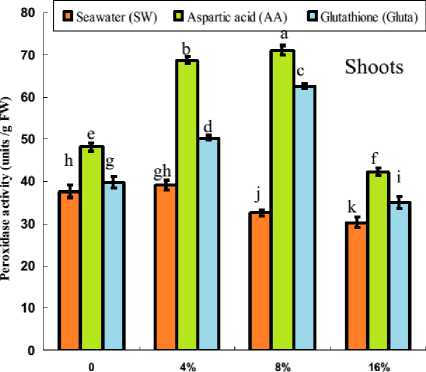
Concentrations of seawater
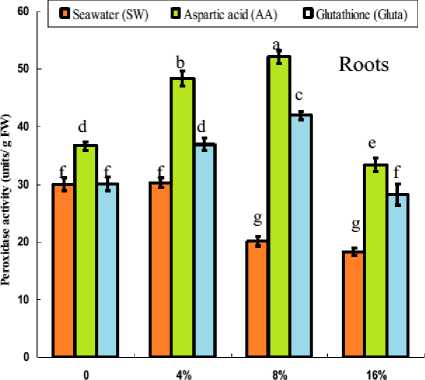
Concentrations ofseawater
Figure 1 (a, b): Effect of foliar spraying with aspartic acid and/or glutathione on peroxidase activity of shoots
and roots of tomato plants grown under saline conditions. Bars represent the means ± standard deviation.
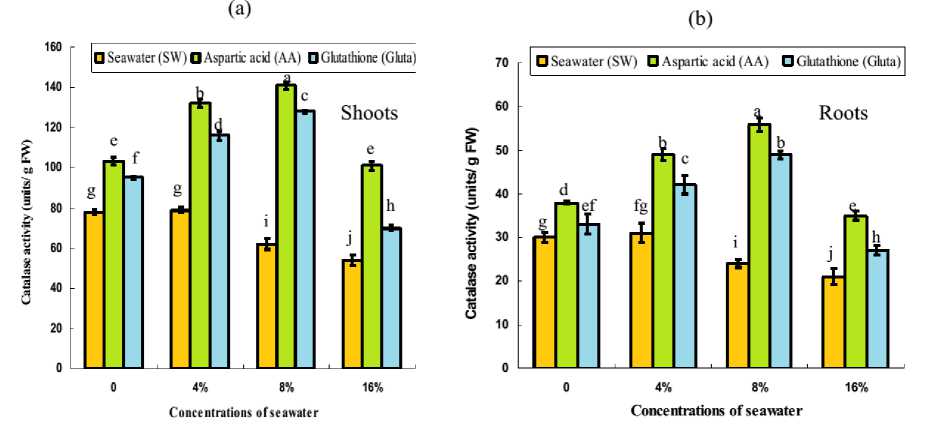
Figure 2 (a, b): Effect of foliar spraying with aspartic acid and/or glutathione on catalase activity of shoots and
roots of tomato plants grown under saline conditions. Bars represent standard the means ± standard deviation.
(а) (b)
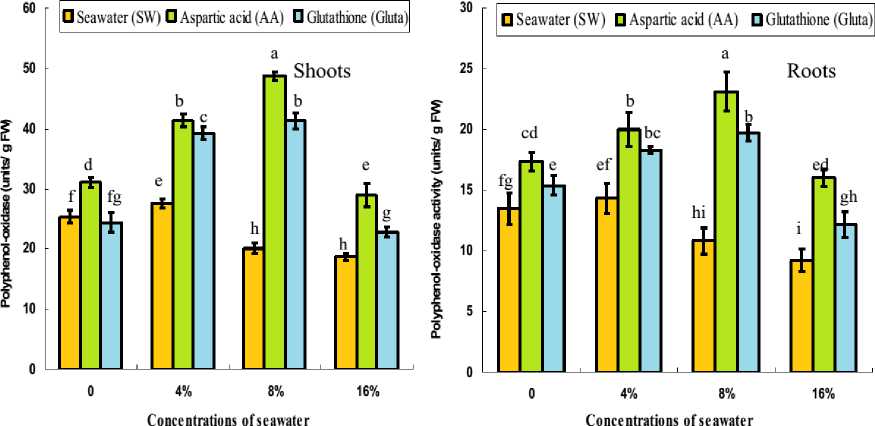
Figure 3 (a, b): Effect of foliar spraying with aspartic acid and/or glutathione on polyphenol-oxidase activity of shoots and roots of tomato plants grown under saline conditions. Bars represent the means ± standard deviation.
12 3 4 5 6 7 8 9 10 11 12 M kDa
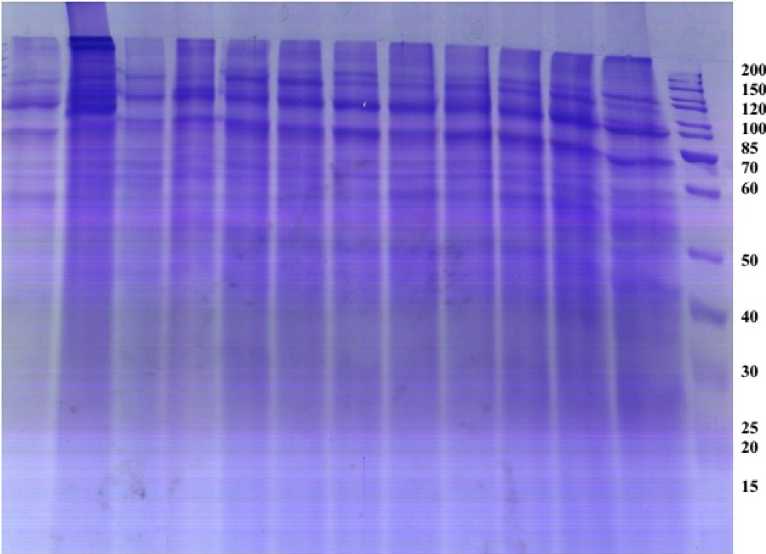
Figure 4 ProteinProfile on SDS-PAGE of the leaves of tomato plants as influenced by foliar spraying with aspartic acid or glutathione and grown under salinity stress. Where: (M)= Marker protein ; (1) = Control; (2) = 4% SW ; (3) = 8% SW ; (4) = 16% SW ; (5) = AA + Tp ; (6) = AA+ 4% SW ; (7) = AA+ 8% SW ; (8) = AA+ 16% SW ; (9) = GlT +Tp ; (10) = GlT + 4% SW ; (11) = GlT + 8% SW ; (12) = GlT + 16% SW .
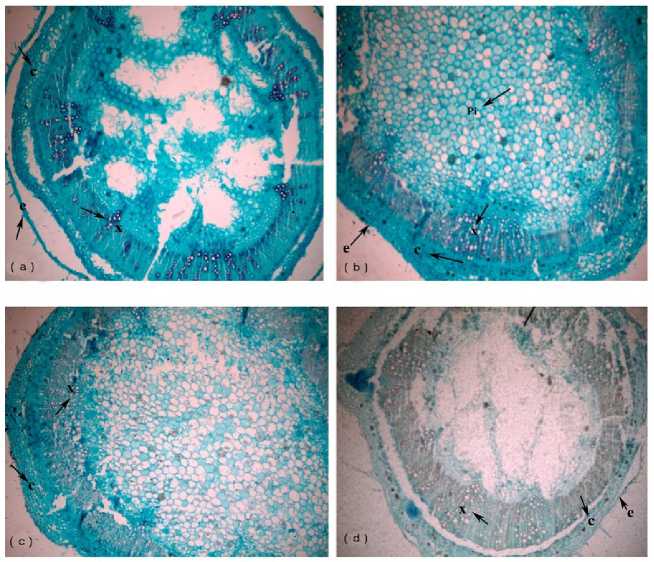
Figure 5 Transverse sections of stem of tomato plants; (a) transverse section of the entire stem of the control (Tap water) plants showing the arrangement of vascular bundles and other stem tissues (X40). (b) transverse section of stem of plants treated with 4% of diluted sea water (X40). (c) transverse section of stem of plants treated with 8% of diluted seawater (X40). (d) transverse section of stem of plants treated with 16% of diluted seawater (X40). (e) epidermis, (c) cortex, (x) xylem, (Pi) pith.
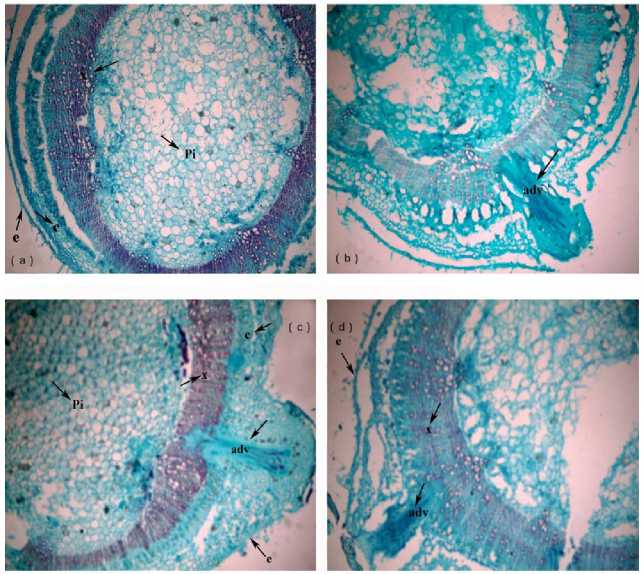
Figure 6 Transverse sections of stem of tomato plants; (a) transverse section of the entire stem of plants treated with aspartic acid +Tap water (X40). (b) transverse section of stem of plants treated with aspartic acid + 4% of diluted seawater (X40). (c) transverse section of stem of plants treated with aspartic acid + 8% of diluted seawater (X40). (d) transverse section of stem of plants treated with aspartic acid + 16% of diluted seawater (X40). (e) epidermis, (c) cortex, (x) xylem, (Pi) pith, (adv) adventitious root.
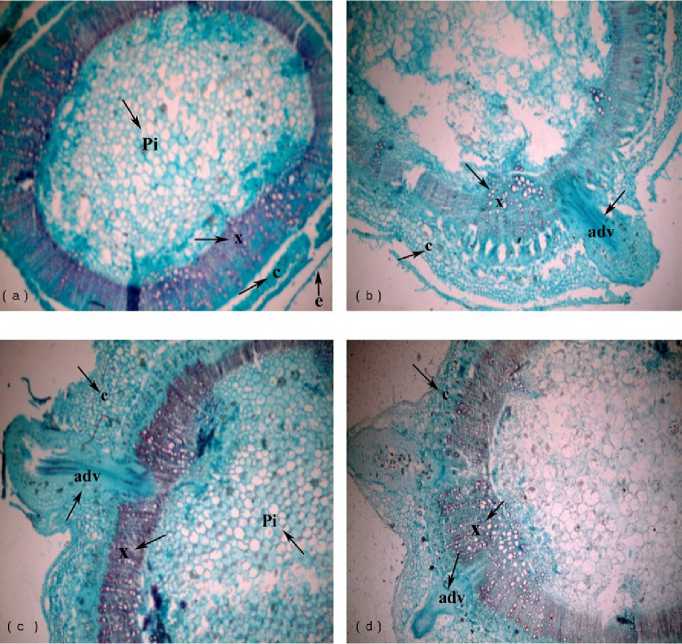
Figure 7 Transverse sections of stem of tomato plants; (a) transverse section of the entire stem of plants treated with glutathione +Tap water (X40). (b) transverse section of stem of plants treated with glutathione + 4% of diluted seawater (X40). (c) transverse section of stem of plants treated with glutathione + 8% of diluted seawater (X40). (d) transverse section of stem of plants treated with glutathione + 16% of diluted seawater (X40). (e) epidermis, (c) cortex, (x) xylem, (Pi) pith, (adv)
adventitious root.
Table 1. Effect of foliar spraying with aspartic acid and/or glutathione on growth parameters of tomato plants irrigated with different concentrations of diluted seawater.
|
Treatments |
Plant Root No. of Leaf area Fresh Wight (g) Dry weight (g) height length leaves/ ( 2) (cm) (cm) plant cm ) Shoots Roots Shoots Roots |
|
Tp (Control) |
31.0 bcd 20.80 de 8.0 cde 81.6 g 28.68 ef 4.31 g 2.86 c 0.57 de |
|
4% SW |
33.10 abc 21.25 de 8.5 bcde 88.3 f 29.35 ef 6.1 ef 2.99 bc 0.69 d |
|
Se(aSwWa)ter 8% SW 16% SW |
26.45 de 18.25 ef 7.5 de 70.6 h 25.22 g 4.39 g 1.64 d 0.4 ef 24.50 e 16.75 f 7.0 e 69.4 h 19.35 h 4.15 g 1.64 d 0.35 f |
|
AA + Tp |
35.20 ab 22.3 bcd 9.5 abc 101.2 e 31.05de 7.55 d 3.24 bc 0.89 c |
|
Aspartic AA+ 4% SW acid (AA) AA + 8% SW |
37.00 a 25.00 b 10.0 ab 135.7 b 37 ab 10.87 ab 3.6 ab 1.39 a 37.65 a 28.95 a 10.5 a 142.6 a 38.8 a 11.33 a 3.97 a 1.42 a |
|
AA+ 16 % SW |
32.55 cde 22.00 de 8.0 cde 105.1 g 30.22 fg 5.87 f 2.96 d 0.59 ef |
|
GlT +Tp |
35.00 ab 22.00cd 9.0 abcd 97.5 e 30.91 e 6.56 e 3.16 bc 0.76 cd |
|
Glutathione GlT + 4% SW (GlT) GlT + 8% SW |
36.00 a 24.45 bc 9.5 abc 119.1 d 33.71 cd 9.48 c 3.31 abc 1.11 b 36.20 a 25.00 b 10.0 ab 130.5 c 35.93 bc 10.62 b 3.47 abc 1.26 ab |
|
GlT +16% SW |
26.80 de 19.0 efj 8.0 cde 72.4 h 25.93 g 4.67 g 1.77 d 0.43 ef |
Tp = Tap water. Data are reported as means (n=5). Means were separated by Duncan’s multiple range tests, different letters indicate a significant difference atP ≤ 0.05.
Table 3. Effect of foliar spraying with aspartic acid and glutathione on electrophoretic pattern of the leaves of tomato plants irrigated with different concentrations of diluted sea water.
|
M. W. (kDa) |
Tap wate r |
Concentrations of SW |
Asp+ Tp |
Aspartic acid + SW |
GlT+ Tp |
Glutathione + SW |
||||||
|
4% |
8% |
16% |
4% |
8% |
16% |
4% |
8% |
16% |
||||
|
355 |
+ |
+ |
+ |
+ |
+ |
+ |
+ |
+ |
+ |
+ |
+ |
|
|
296 |
+ |
+ |
+ |
+ |
+ |
|||||||
|
202 |
+ |
+ |
+ |
|||||||||
|
164.17 |
+ |
+ |
+ |
+ |
+ |
+ |
||||||
|
132.19 |
+ |
+ |
+ |
+ |
+ |
+ |
+ |
+ |
||||
|
106.44 |
+ |
+ |
+ |
+ |
+ |
|||||||
|
90.05 |
+ |
+ |
+ |
+ |
+ |
+ |
+ |
|||||
|
77.40 |
+ |
+ |
+ |
+ |
+ |
|||||||
|
62.51 |
+ |
+ |
+ |
+ |
+ |
+ |
+ |
+ |
+ |
+ |
+ |
|
|
54.12 |
+ |
+ |
+ |
+ |
+ |
+ |
+ |
+ |
+ |
+ |
+ |
|
|
48.06 |
+ |
+ |
+ |
+ |
+ |
+ |
+ |
+ |
+ |
+ |
+ |
|
|
44.39 |
+ |
+ |
+ |
+ |
+ |
+ |
+ |
+ |
||||
|
42.11 |
+ |
+ |
+ |
+ |
+ |
+ |
||||||
|
39.25 |
+ |
+ |
+ |
+ |
+ |
+ |
+ |
+ |
+ |
+ |
+ |
+ |
|
37.26 |
+ |
+ |
+ |
+ |
+ |
+ |
+ |
+ |
+ |
+ |
||
|
35.08 |
+ |
+ |
+ |
+ |
+ |
+ |
+ |
+ |
||||
|
33.68 |
+ |
+ |
+ |
+ |
+ |
+ |
+ |
+ |
+ |
+ |
+ |
|
|
31.95 |
+ |
+ |
+ |
+ |
+ |
+ |
+ |
+ |
+ |
+ |
+ |
|
|
30.21 |
+ |
+ |
+ |
+ |
+ |
+ |
+ |
+ |
+ |
+ |
+ |
|
|
28.50 |
+ |
+ |
+ |
+ |
+ |
+ |
+ |
+ |
+ |
+ |
+ |
|
|
27.20 |
+ |
+ |
+ |
+ |
+ |
+ |
+ |
+ |
+ |
+ |
+ |
+ |
|
25.91 |
+ |
+ |
+ |
+ |
+ |
+ |
+ |
+ |
+ |
+ |
+ |
|
|
24.83 |
+ |
+ |
+ |
+ |
+ |
+ |
+ |
+ |
+ |
+ |
+ |
+ |
|
22.98 |
+ |
+ |
+ |
+ |
+ |
+ |
+ |
+ |
+ |
+ |
||
|
21.84 |
+ |
+ |
+ |
+ |
+ |
+ |
||||||
|
19.28 |
+ |
+ |
+ |
+ |
+ |
+ |
+ |
+ |
+ |
+ |
+ |
|
|
19.52 |
+ |
+ |
+ |
+ |
+ |
+ |
+ |
+ |
+ |
+ |
+ |
|
|
17.96 |
+ |
+ |
+ |
|||||||||
|
16.61 |
+ |
+ |
+ |
+ |
+ |
+ |
+ |
+ |
+ |
+ |
+ |
|
|
14.60 |
+ |
+ |
+ |
+ |
+ |
+ |
+ |
+ |
+ |
+ |
+ |
+ |
|
10.16 |
+ |
+ |
+ |
+ |
+ |
+ |
+ |
+ |
+ |
+ |
+ |
+ |
|
7.26 |
+ |
+ |
+ |
+ |
+ |
+ |
+ |
+ |
+ |
+ |
+ |
+ |
|
Total No. of bands |
21 |
21 |
25 |
26 |
26 |
25 |
26 |
22 |
24 |
26 |
27 |
25 |
|
No. of new bands |
6 |
8 |
7 |
9 |
8 |
9 |
5 |
5 |
6 |
9 |
8 |
|
Table 4. Effect of foliar spraying with aspartic acid and/or glutathione on amino acids content of tomato plants irrigated with different concentrations of diluted seawater.
|
Major components (µg/mL) |
Tap water |
Concentrations of SW |
Tp + AA |
Aspartic acid + SW |
Tp + GlT |
Glutathione + SW |
||||||
|
4% |
8% |
16% |
4% |
8% |
16% |
4% |
8% |
16% |
||||
|
Aspartic |
13.15 |
13.52 |
14.53 |
16.14 |
17.74 |
31.16 |
44.67 |
15.85 |
16.74 |
29.41 |
38.65 |
14.32 |
|
Threonine |
5.07 |
3.78 |
2.41 |
1.37 |
6.02 |
7.23 |
10.03 |
5.18 |
5.62 |
6.51 |
9.85 |
5.71 |
|
Glutamic acid |
19.51 |
25.41 |
28.52 |
31.94 |
25.31 |
41.94 |
54.21 |
40.38 |
33.62 |
41.25 |
48.31 |
20.21 |
|
Proline |
3.37 |
18.16 |
26.72 |
29.12 |
14.51 |
25.31 |
34.61 |
17.65 |
11.31 |
23.62 |
28.61 |
7.65 |
|
Glycine |
5.08 |
4.46 |
5.02 |
4.11 |
5.66 |
13.31 |
15.78 |
5.18 |
6.23 |
10.96 |
13.21 |
4.44 |
|
Alanine |
5.40 |
4.38 |
5.10 |
3.52 |
5.02 |
10.62 |
14.90 |
4.64 |
4.91 |
9.35 |
12.61 |
4.21 |
|
Cystine |
-- |
-- |
-- |
0.0081 |
0.0048 |
0.0011 |
0.0041 |
0.0014 |
0.0032 |
0.0043 |
0.005 |
0.0012 |
|
Methionine |
2.31 |
1.70 |
1.35 |
1.12 |
3.41 |
4.31 |
6.31 |
2.98 |
4.06 |
4.62 |
5.24 |
3.90 |
|
Isoleucine |
3.57 |
2.93 |
3.15 |
1.96 |
4.15 |
5.30 |
6.45 |
3.25 |
3.96 |
4.82 |
6.21 |
3.14 |
|
Leucine |
5.12 |
5.16 |
5.11 |
4.42 |
6.13 |
10.23 |
15.62 |
4.61 |
6.41 |
8.76 |
13.58 |
3.92 |
|
Tyrosine |
2.32 |
5.00 |
8.10 |
3.67 |
8.5 |
3.21 |
10.21 |
1.93 |
7.3 |
4.15 |
9.25 |
1.14 |
|
Phenyl-alanine |
6.21 |
3.69 |
5.31 |
4.27 |
5.31 |
10.21 |
13.21 |
4.32 |
4.35 |
8.65 |
11.45 |
4.06 |
|
Histidine |
6.10 |
7.34 |
7.91 |
7.13 |
5.23 |
11.42 |
18.65 |
5.31 |
4.61 |
8.96 |
15.32 |
4.97 |
|
lysine |
5.17 |
5.46 |
7.23 |
6.34 |
7.08 |
11.21 |
16.37 |
4.13 |
5.54 |
10.53 |
14.14 |
3.81 |
|
Arginine |
5.67 |
6.06 |
9.61 |
11.94 |
9.52 |
19.43 |
22.31 |
12.32 |
8.93 |
9.41 |
18.51 |
10.61 |
|
Serine |
4.75 |
2.96 |
4.12 |
3.54 |
7.94 |
8.21 |
16.67 |
4.13 |
6.95 |
7.63 |
13.85 |
3.72 |
|
Valine |
0.86 |
0.81 |
0.86 |
0.03 |
2.41 |
7.93 |
8.87 |
0.75 |
2.13 |
6.52 |
7.10 |
0.71 |
Table 5. Counts and measurements (in microns) of certain histological features in transverse section through the stem of tomato plant treated with aspartic acid and/or glutathione and grown under different concentrations of diluted seawater.
|
Treatments |
Stem diameter |
Epidermis thick. |
Cortex thick. |
Xylem tissue thick. |
|
Tap water (Control) |
3475.00 |
12.00 |
310.80 |
145.00 |
|
4 % SW |
3581.50 |
12.5 |
350.25 |
160.00 |
|
Se(aSwWa)ter 8 % SW 16 % SW |
3187.00 |
11.00 |
250.50 |
125.00 |
|
3050.00 |
10.25 |
225.90 |
110.50 |
|
|
AA+ Tp |
3940.5 |
13.00 |
430.25 |
187.50 |
|
Aspartic AA+ 4 % SW acid |
4125.00 |
14.00 |
470.50 |
250.00 |
|
(AA) AA + 8 % SW |
4200.00 |
14.75 |
480.00 |
280.00 |
|
AA+ 16 % SW |
3825.00 |
13.00 |
410.00 |
170.50 |
|
GlT + Tp |
3662.00 |
13.00 |
400.00 |
165.00 |
|
Glutathione GlT + 4% SW |
4050.00 |
13.50 |
450.90 |
225.00 |
|
(GlT) GlT + 8% SW |
4125.00 |
14.00 |
462.50 |
225.00 |
|
GlT +16% SW |
3250.00 |
11.30 |
285.20 |
138.50 |
Amino acids represent one of the important classes of metabolites in the cell because they are the building blocks of proteins, which form the chemical basis necessary for life and have a many of roles in metabolism. Asparagine in particular functions as osmolyte to balance water potential within the cells, especially when nitrogen availability exceeds the need for growth. Moreover, total amino acid content in mung bean seeds found to be adversely affected due to salinity effect (Hassanein et al., 2008). Amino acids such as proline, asparagines and aminobutyric acid, play an important role in the osmotic adjustment of the plant under saline conditions (El-Bassiouny and Bakheta, 2005). The accumulation in amino acids in plants exposed to stress probably attributed to the disturbance in amino acid metabolism (Hemmat, 2007). The impaired plant health results in ammonia accumulation during the stress period and that the detoxification process by which excess ammonium in the cells is removed, results in the accumulation of nitrogen containing compounds such as glutamine, arginine and proline (El– Bassiouny, 2008). Hassanein et al. (2008) indicated that arginine was the effective compound in increasing proline, total amino acid and protein contents of wheat plants under normal or stressed condition. Glutathione significantly enhanced the stimulatory role of slat stress on the production of free amino acid in cv. Pactol green plants (El– Bassiouny, 2008).
Anatomical changes: The results of the effects of aspartic acid and / or glutathione application at all the used levels of salinity were represented in table (5) and figs (5-7). Salt stress decreased the stem diameter, epidermis cell size, cortex zone thickness, number of xylem vessels in plants irrigated with the highest concentration of seawater (16%) in comparison with the control plants. n the other hand, spraying the plants with aspartic acid or glutathione increased stem diameter, epidermis cell size, numbers of xylem vessels in comparison with the control plants. Moreover, application of aspartic acid and / or glutathione at all different levels of salinity often caused obvious increase in the mentioned characters and the appearance of some adventitious roots, which observed only by using these amino acids accompanied by exposure the plants to salinity levels. Since these adventitious roots were, absent in either control plants or in plants treated with salinity only. Thus, amino acids treatment was mostly determined to have a successful performance in ameliorating of the inhibitory effects of salinity on stem anatomy of tomato plants.
The changes in stem anatomy of tomato plants caused by salinity stress appeared as a results of osmotic effect and the difficulty of water uptake from the saline soil. Reducing effects of salt stress on stem diameter (Pimmongkol et al., 2002), epidermis cell width, cortex zone thickness and xylem width were reported previously.
The increase in stem diameter, epidermis cell width, cortex zone thickness and the number of xylem vessels which induced by using aspartic acid or glutathione indicate that salt stress on the stems of tomato may be reduced by using of these antioxidants. The mentioned large cells of the stems of salinized plants treated with aspartic acid or glutathione may results from increased cell wall extensibility together with higher turgor pressures (Munns and Termaat, 1986). The results indicated that the loosening of the cell wall under turgor pressure initiates cell expansion followed by water and solute uptake, the cell expansion is an expression of water uptake and cell wall extension (Boyer, 2001). It was reported that salinity affects synthesis of carbohydrates as well as transport of photosynthetic products and their utilization in the formation of new tissues. The observations revealed that cortex zone thickness and epidermis cell width increased under saline conditions by treating the plants with aspartic acid or glutathione. These results could fit with those obtained by Ali (2001) who found that application of ascorbic acid (antioxidant) at different concentrations (200, 400 or 600 ppm) on two cultivars of tomato induced anatomical changes in the stem of both the two cultivars. He also indicated that application of ascorbic acid at 200 or 400 ppm increased stem diameter and cortical layer thickness. The presence of some adventitious roots which produced from the stem in plants treated with amino acids and grown under saline conditions confirm that these amino acids increase the tolerance capacity of plants to overcome the saline conditions by increasing their ability to absorb more amounts of water.
Список литературы Alleviation of seawater stress on tomato by foliar application of aspartic acid and glutathione
- Abo Sedera, F.A., Amany, A.L., Abd El-Latif, A.A., Bader, A. and Rezk, S.M. (2010) Effect of NPK mineral fertilizer levels and foliar application with humic and amino acids on yield and quality of strawberry. Egyp. J. Appl. Sci., 25, 154-169.
- Ali, Z.A. (2001) Ascorbic acid induced anatomical changes in the leaves and stems of tomato plants. Bull. National Res. Centre Egyp., 26(3), 371-382.
- Apte, S.K. and Bhagwat, A.A. (1998) Salinity-stress-induced proteins in two nitrogen-fixating Anabaena strains deferentially tolerant to salt. J. Bacteriol., 171, 909-15.
- Azevedo, A.D., Prisco, J.T., Filho, J.E., Lacerda, C.F., Silva, J.V., Costa, P.H.A. and Filho, E.G. (2004) Effect of salt stress on plant growth, stomatal response and solute accumulation of different maize genotypes. Braz. J. Plant Physiol., 16, 1677-1590.
- Blokhina, O., Virolainen, E. and Fagerstedt, K.V. (2003) Antioxidants, oxidative damage and oxygen deprivation stress. A review Annales Botany 91, 179-194.
- Boyer, J.S. (2001) Growth-induced water potentials originate from wall yielding during growth. J. Exp. Bot., 52, 1483-1488.
- Bradford, M.M. (1976) A rapid and sensitive method for the quantification of microgram quantities of protein utilising the principal of protein -dye binding. Anal Biochem. 72, 248-254.
- Chandlee, J.M. and Scandalios, J.G. (1984) Analysis of variants affecting the catalase development program in maize scutellum. Theor. Appl. Gen., 69, 71-77.
- Dash, M. and Panda, S.K. (2001) Salt stress induced changes in growth and enzyme activities in germinating Phaselous mungo seeds. Plant Biol., 44, 587-589.
- El-Bassiouny, H.M. and Bakheta, M.A. (2005) Effect of salt stress on relative water content, lipid peroxidation, polyamines, amino acids and ethylene of two wheat cultivars. Inter J. Agric. and Biol., 7, 363-365.
- El-Bassiouny, H.M., Mostafa, H.A., El-Khawas, S.A., Hassanein, R.A., Khalil, S.I. and Abd El-Monem, A.A. (2008) Physiological responses of wheat plant to foliar treatments with arginine or putrescine. Aus. J. Basic and Appl. Sci., 2(4), 1390-1403.
- Gamal El-Din, K.M. and Abd El-Wahed, M.S. (2005) Effect of some amino acids on growth and essential oil content of chamomile plant. Inter J. Agric. Biol., 7, 376-380.
- Garcia, G.D., Ferreira, P.A., Miranda, G.V., Neves, J.C., Moraes, W.B. and Santos, D.B. (2007) Leaf contents of cationic macronutrients and their relationships with sodium in maize plants under saline stress. IDESIA 25,93-106.
- Gehrke, C.W., Wall, L.L., Absheer, J.S., Kasier, F.E. and Zumwalt, W. (1985) Sample preparation for chromatography of amino acids: acid hydrolysis of proteins. J. Assoc. of Official Anal. Chem., 68-81.
- Hassanein, R.A., Khalil, S.I., El-Bassiouny, H.M., Mostafa, H.A., El-Khawas, S.A. and Abd El-Monem, A.A. (2008) Protective role of exogenous arginine or putrescine treatments on heat shocked wheat plant. 1st International Conference on Biological and Environmental Sciences, 13-16 March, Hurghada, Egypt.
- Hemmat, K. (2007) Role of glutathione and polyadenylic acid on the oxidative defense systems of two different cultivars of canola seedlings grown under saline condition. Aust J of basic and Appl Sci., 1(3), 323-334.
- Hernandez, J., Jimenez, A., Mullineaux, P. and Sevilla, F.N. (2000) Tolerance of pea plants (Pisum sativum) to long-term salt stress is associated with induction of antioxidant defenses. Plant Cell Environ., 23, 853-862.
- Jui-Hung, C., Han-Wei, J., En-Jung, H., Hsing-Yu, C., Ching-Te, C., Hsu-Liang, H. and Tsan-Piao, L. (2012) Drought and salt stress tolerance of an arabidopsis glutathione S-Transferase U17 knockout mutant are attributed to the combined effect of glutathione and abscisic acid. Plant Physiol., 158, 340-351.
- Koyro, H.W. (2006) Effect of salinity on growth, photosynthesis, water relations and solute composition of the potential cash crop halophyte Plantago coronopus (L-). Environ. Exp. Bot., 56, 136-146.
- Krizek, D.T., Kramer, G.F., Upadhyaya, A. and Mirecki, R.M. (1993) UV-B Response of cucumber seedling grown under metal halid and high pressure sodium/deluxe lamps. Plant physiol., 88, 350-358.
- Kumar, K.B. and Khan, P.A. (1982) Peroxidase and polyphenol oxidase in excised ragi (Eleusine coracana cv. PR 202) leaves during senescence. Ind. J. Exp. Bot., 20, 412-416.
- Laememli, U.K. (1970) Cleavage of structure proteins during the assembly of the head of bacteriophageT4. Nature 227, 680-685.
- Mitsuya, S., Takeoka, Y. and Miyake, H. (2000) Effects of sodium chloride on foliar ultrastructure of sweet potato (Ipomoea batatas Lam.) plantlets grown under light and dark conditions in vitro. Plant Physiol., 157, 661-667.
- Mittler, R. (2002) Oxidative stress, antioxidants and stress tolerance. Trends in Plant Sci., 7, 405-410.
- Mukherjee, S.P. and Choudhuri, M.A. (1983) Implications of water stress-induced changes in the levels of endogenous ascorbic acid and hydrogen peroxide in Vigna seedlings. Plant Physiol., 58, 166-170.
- Munns, R. and Termaat, A. (1986) Whole-plant responses to salinity. Aus. J Plant Physiol. 13, 143-160.
- Nassar, M.A. and El-Sahhar, K.F. (1998) Botanical preparations and Microscopy (Microteqnique) Academic Bookshop, Dokki, Giza, Egypt., pp, 219
- Philip, B., Bernard, L. and William, H. (1954) Vitamins and Deficiency Diseases, In, Practical Physiological Chemistry, McGraw-Hill company, INC. New York, Toronto, London, 1272-1274.
- Pimmongkol, A., Terapongtanakhon, S. and Udonsirichakhon, K. (2002) Anatomy of a salt -and non-salt-tolerant rice treated with NaCl. In: 28th Congr. Science and Technology of Thailand, Bangkok, Thailand.
- Rawia, A.E., Lobna, S.T. and Soad, M.I. (2011) Alleviation of Adverse Effects of Salinity on Growth, and Chemical Constituents of Marigold Plants by Using Glutathione and Ascorbate. J. Appl Sci Res., 7(5), 714-721.
- Sairam, R.K., Srivastava, G.C., Agarwal, S.A. and Meena, R.C. (2005) Differences in antioxidant activity in response to salinity stress in tolerant and susceptible wheat genotypes. Plant Biol., 49, 85-91.
- Vaidyanathan, H., Sivakumar, P., Chakrabarsty, R., and Thomas, G. (2003) Scavenging of reactive oxygen species in NaCl-stressed rice (Oryza sativa L.)-differential response in salt-tolerant and sensitive varieties. Plant Sci., 165, 1411-1418.
- Wahba, H., Mohamed, S.M., Attoa, G.E., and A.A. Farahat (2002). Response of Antholyza aethiopica to foliar spray with some amino acids and mineral nutrition with sulfur. Annales Agric. Sci., 47, 929-944.

